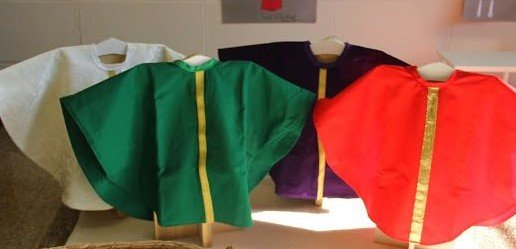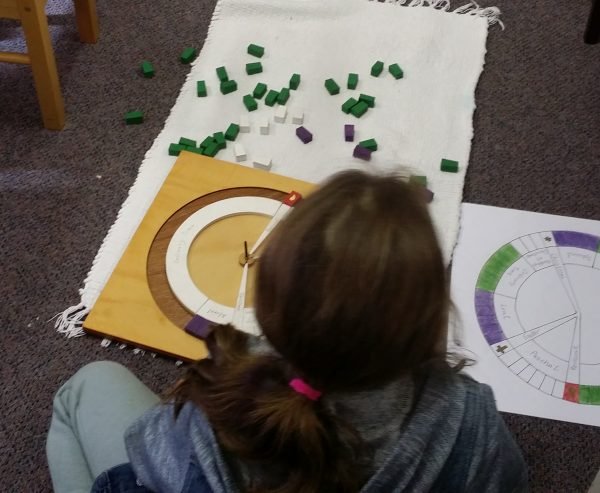In the atrium we introduce the children to the liturgical year firstly by looking at the colours of the liturgical seasons. Children in level 1 are introduced to the colours for Preparation (purple), getting ready for a feast. The feasts of Christmas and Easter and their seasons are white. Ordinary time (green) is introduced as the growing time, a time to allow the “food of the feast” to nurture our growing relationship with God. The other colour (red) is for the Holy Spirit and the feast of Pentecost.

As children progress through the atrium we look at a circular liturgical calendar. This highlights the cyclical nature of the liturgical year. The calendar has a small prism for each Sunday of the year (ours also includes an extra prism to represent Christmas Day as that does not always fall on a Sunday). Essentially this work is a puzzle that the children pull apart and reconstruct. However, this provides time for the children to reflect and notice different elements of our liturgical cycle. Little facts such as Easter is longer than Lent. Ordinary Time is very long, why would that be?

There are also things to research further such as Easter is not always on the same date so how do we know when it will happen? The numbers of the Sundays in Ordinary Time don’t match the number of prisms, why would that be? When we attend daily Mass the priest sometimes wears other colours, why?

The calendar is just a starting point for discoveries about life in the church.
Many adults make observations too such as the calendar does not progress in a clockwise direction. Why would we have it going counter-clockwise? Could it be that God’s time is different to our time?
As we approach the three main feasts of our church year, Easter, Christmas and Pentecost, we celebrate with the children. These celebrations are not just parties with gifts and food. They are solemn celebrations looking at what the event is. With the children we enter into the special time that we are celebrating. At Easter, this may take the form of a re-enactment of the Last Supper and/or a Liturgy of Light celebration. Prior to that, during Lent, we bury the “Alleluia” and save the word for the special day when we proclaim the resurrection of Jesus. During Pentecost we meditate on the gift of the Holy Spirit and consider what those gifts mean for us in our lives and how we can call on those gifts to help us build God’s kingdom. During the Christmas Celebration we often have a lead up during advent culminating in recalling Jesus being incarnate and also longing for him to come again. Due to our long Summer break, this often happens a few weeks prior to Christmas Day. Our CGS friends living in the Northern Hemisphere will also celebrate the feast of Epiphany, recognising the gift given for all people.

Parents may be able to foster a sense of the liturgical year in their homes by preparing for the children a small table for prayer. Provide cloths in each of the 4 liturgical colours that the children can place on the table according to the season. Add a candle and perhaps a small statue of the Good Shepherd, the Holy Family etc. Children enjoy spending time in quiet prayer or communal prayer, including songs and hand made prayer cards. Ideas for short phrases can be taken from words used in the Mass such as “Amen”, “Alleluia”, “Thanks be to God”, “Holy, holy, holy”, “Thy kingdom come”. Other ideas can be found in the book “The Good Shepherd and the Child a Joyful Journey”.
